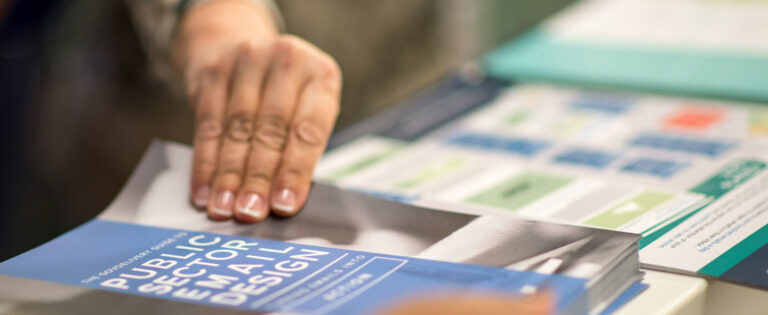
Sending good emails is crucial to citizen engagement and a positive citizen experience. However, most individuals receive up to 100 emails a day, making it difficult for agencies to break through the clutter and make their emails stand out.
At GovDelivery’s recent breakfast series, How to Design Great Emails, Allison Hamilton, Federal Client Success Consultant at GovDelivery, discussed some ways you can design the most effective emails at your agency.
In order to improve citizen engagement, agencies must give citizens a cohesive experience, develop relevant content, provide a clear and visual call to action, build mobile platforms, and incorporate action verbs. And while most readers see emails as a single entity, there are a lot of components that go into an email that you can use to enhance citizen engagement:
From Name: The from name in your emails should be something that your audience trusts and is familiar with and tailored to your organization or department. Hamilton explained that this is the first thing people see in an email and if it does not resonate with an outside audience, they will be less likely to open the email.
Subject Lines: It is critical that subject lines also capture the recipient’s attention. But agencies must be careful with what they put into a subject line. “It is best to keep the subject line concise and in context. Typically, you can only include 50 characters, or 8 words, but you should also be cognizant that many mobile devices only display about 35 characters,” Hamilton explained. The entire subject line should be compelling but it is valuable to frontload the most relevant information.
Preheader Text: This section of text is a snippet of text placed after the subject line in an inbox. The preheader text is the first piece of content in the body of the email and should build upon the subject line and further compel recipients to open your emails. Hamilton advised making this text customizable to each email so the individuals receiving the emails don’t feel like they are receiving the same ones over and over.
Above the Fold Area: This part of the email is what is displayed in the preview pane and what your audience will see first when they open the email. The content displayed here is pulled from the top 2-4 inches of the email so it is critical that your most important information is included there. Hamilton recommended including a banner or header that reflects the organizations’ brand identity or the call to action message of the email in this space.
Once your agency has a better grasp on the specific components of an email, you can work towards creating an overall user-friendly layout. Hamilton gave a few examples of how your agency can work towards this:
Think Mobile First: Depending on your user base, it is likely that many of your end users are viewing your emails on a mobile device. As a result, Hamilton advised using short snippets of text with a larger font as well as larger buttons. She emphasized that using buttons instead of hyperlinks increase click through rates and the ability for recipients to share the email. Additionally, it is key to keep your emails’ width no larger than 500-700 pixels to avoid making your users scroll from left to right to view the entire email.
Use Compelling Graphics: Graphics can enhance your emails if they are used in a way that attract interest and help visually convey the subject matter. In particular, unique images help drive click through rates and make the email easier to scan, streamlining the user experience. Hamilton also suggested including screen grabs of videos that link back to the video as these have shown to increase click rates by almost 300 percent.
Streamline Your Voice: Hamilton advised creating concise content with a consistent tone that reflects your organization’s personality. Ways to achieve this include short sentences and paragraphs, using plain language guidelines, and asking your audience to share your email.
GovDelivery’s Advanced Package is one way agencies can fully implement the aforementioned tips. The Advanced Package allows agencies to test and send two variables like subject lines or images to better optimize a marketing campaigns success, includes pre-built campaigns that increase engagement metrics and deliverability through automated touch-points, and audience segmentation to save audiences based on important insights.
Hamilton brought in Hadiza Buge, Chief of Electronic Media and Communication at the Bureau of Alcohol, Tobacco, Firearms and Explosives (ATF), to discuss how ATF has used GovDelivery solutions to boost their engagement and how they will use the Advanced Package once they procure it.
When Buge first got to ATF she realized that the way they were using email communication and web pages needed to be redesigned. “When I first started, we had very low engagement rates and a lot of different lists,” she explained. As a result, she wanted to condense in order to more effectively engage citizens. By using GovDelivery’s platform, Buge and her team were able to boost engagement by condensing over 100 lists into 5 critical ones and redesign their webpage to reflect a more user-friendly interface. Doing so simplified the subscriber experience and drove increased engagement.
Buge also stressed that GovDelivery’s Advanced Package would have made these efforts much easier. One of her biggest issues throughout the transformation process was fostering stakeholder buy-in. “Access to A/B testing and other Advanced Package features would have been a more efficient way to convince stakeholders that one way of doing things was better than another,” Buge concluded.
Now is the time to take a good look at your agencies emails and make sure that they are the best they can be. Implement these tips and check out GovDelivery’s Public Sector Guide to Email Design for more information.